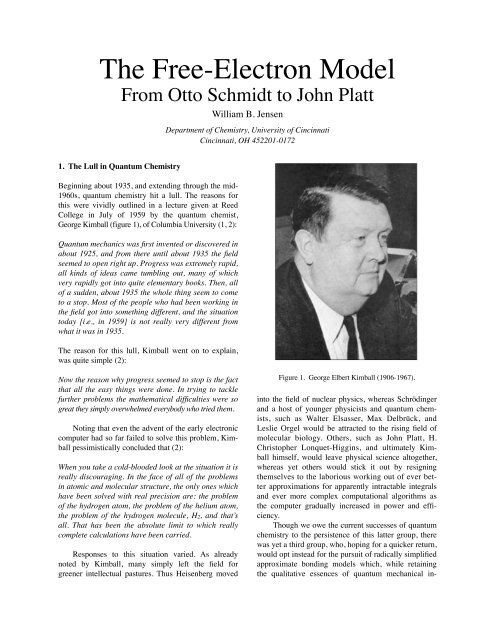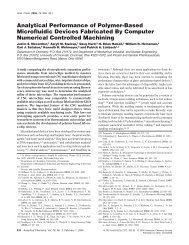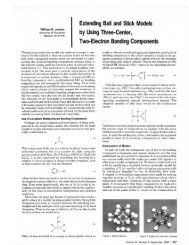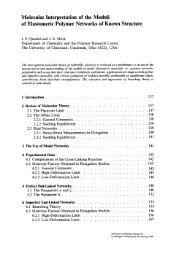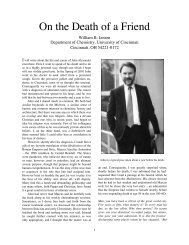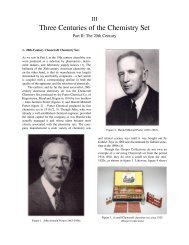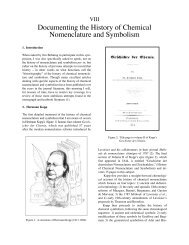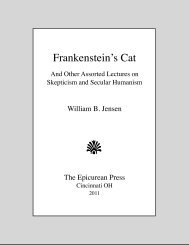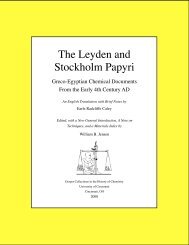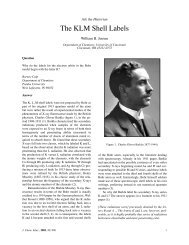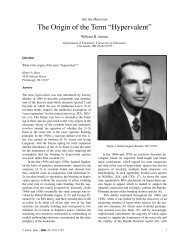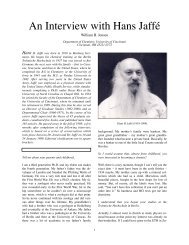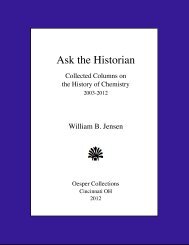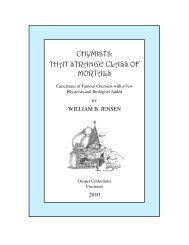198. Free Electron.pdf - University of Cincinnati
198. Free Electron.pdf - University of Cincinnati
198. Free Electron.pdf - University of Cincinnati
Create successful ePaper yourself
Turn your PDF publications into a flip-book with our unique Google optimized e-Paper software.
The <strong>Free</strong>-<strong>Electron</strong> Model<br />
From Otto Schmidt to John Platt<br />
William B. Jensen<br />
Department <strong>of</strong> Chemistry, <strong>University</strong> <strong>of</strong> <strong>Cincinnati</strong><br />
<strong>Cincinnati</strong>, OH 452201-0172<br />
1. The Lull in Quantum Chemistry<br />
Beginning about 1935, and extending through the mid-<br />
1960s, quantum chemistry hit a lull. The reasons for<br />
this were vividly outlined in a lecture given at Reed<br />
College in July <strong>of</strong> 1959 by the quantum chemist,<br />
George Kimball (figure 1), <strong>of</strong> Columbia <strong>University</strong> (1, 2):<br />
Quantum mechanics was first invented or discovered in<br />
about 1925, and from there until about 1935 the field<br />
seemed to open right up. Progress was extremely rapid,<br />
all kinds <strong>of</strong> ideas came tumbling out, many <strong>of</strong> which<br />
very rapidly got into quite elementary books. Then, all<br />
<strong>of</strong> a sudden, about 1935 the whole thing seem to come<br />
to a stop. Most <strong>of</strong> the people who had been working in<br />
the field got into something different, and the situation<br />
today [i.e., in 1959] is not really very different from<br />
what it was in 1935.<br />
The reason for this lull, Kimball went on to explain,<br />
was quite simple (2):<br />
Now the reason why progress seemed to stop is the fact<br />
that all the easy things were done. In trying to tackle<br />
further problems the mathematical difficulties were so<br />
great they simply overwhelmed everybody who tried them.<br />
Noting that even the advent <strong>of</strong> the early electronic<br />
computer had so far failed to solve this problem, Kimball<br />
pessimistically concluded that (2):<br />
When you take a cold-blooded look at the situation it is<br />
really discouraging. In the face <strong>of</strong> all <strong>of</strong> the problems<br />
in atomic and molecular structure, the only ones which<br />
have been solved with real precision are: the problem<br />
<strong>of</strong> the hydrogen atom, the problem <strong>of</strong> the helium atom,<br />
the problem <strong>of</strong> the hydrogen molecule, H2, and that’s<br />
all. That has been the absolute limit to which really<br />
complete calculations have been carried.<br />
Responses to this situation varied. As already<br />
noted by Kimball, many simply left the field for<br />
greener intellectual pastures. Thus Heisenberg moved<br />
Figure 1. George Elbert Kimball (1906-1967).<br />
into the field <strong>of</strong> nuclear physics, whereas Schrödinger<br />
and a host <strong>of</strong> younger physicists and quantum chemists,<br />
such as Walter Elsasser, Max Delbrück, and<br />
Leslie Orgel would be attracted to the rising field <strong>of</strong><br />
molecular biology. Others, such as John Platt, H.<br />
Christopher Lonquet-Higgins, and ultimately Kimball<br />
himself, would leave physical science altogether,<br />
whereas yet others would stick it out by resigning<br />
themselves to the laborious working out <strong>of</strong> ever better<br />
approximations for apparently intractable integrals<br />
and ever more complex computational algorithms as<br />
the computer gradually increased in power and efficiency.<br />
Though we owe the current successes <strong>of</strong> quantum<br />
chemistry to the persistence <strong>of</strong> this latter group, there<br />
was yet a third group, who, hoping for a quicker return,<br />
would opt instead for the pursuit <strong>of</strong> radically simplified<br />
approximate bonding models which, while retaining<br />
the qualitative essences <strong>of</strong> quantum mechanical in-
WILLIAM B. JENSEN<br />
sights, would remain mathematically tractable – if <strong>of</strong><br />
low quantitative accuracy. Indeed, this third approach<br />
was taken by Kimball himself before ultimately deserting<br />
the field altogether. As he explained in his lecture (2):<br />
The other problems have produced an almost ridiculous<br />
flow <strong>of</strong> approximate calculations. It struck me,<br />
some time ago, that there was a remarkable feature<br />
that all these approximate calculations had in common,<br />
and that was that, starting from almost any old<br />
assumption, including some that were definitely known<br />
to be wrong, one ground a mathematical crank and<br />
came out with answers that were within 10% or so <strong>of</strong><br />
the truth. Almost any assumption would give that<br />
degree <strong>of</strong> accuracy; but even the most sophisticated<br />
work, trying to improve that degree <strong>of</strong> accuracy, got<br />
nowhere.<br />
Well I beat my head against this business about<br />
trying to get better accuracy for a long time, and<br />
finally I got tired <strong>of</strong> it and said, “Let’s try a different<br />
angle. Instead <strong>of</strong> trying to make a better calculation,<br />
let’s try reversing the situation and see how bad a calculation<br />
we can make and still come out with the same<br />
first approximation.” There seemed to be abundant<br />
evidence that you could make perfectly terrible first<br />
approximations and come out with this 10% sort <strong>of</strong><br />
accuracy.<br />
The result <strong>of</strong> Kimball’s discontent was his development,<br />
via the Ph.D theses <strong>of</strong> five graduate students<br />
spanning the period 1952-1957, <strong>of</strong> an approximate<br />
localized MO model known as the “charge-cloud<br />
model” which became the basis <strong>of</strong> the 1964 CBA high<br />
school chemistry textbook and was further refined,<br />
under the rubric <strong>of</strong> the “tangent-sphere model,” in a<br />
series <strong>of</strong> more than a dozen papers and reviews published<br />
by Henry Bent during the 1960s (3).<br />
Likewise the early work <strong>of</strong> Linnett and Mellish<br />
was amplified by Nyholm and Gillespie in 1957 and<br />
further refined by Gillespie throughout the 1960s into<br />
what is now known as the “Valence-Shell <strong>Electron</strong> Pair<br />
Repulsion” or “VSEPR” model <strong>of</strong> molecular geometry<br />
(4), and Linnett, again during the 1960s, eventually<br />
elaborated his earlier work into a refinement <strong>of</strong> the original<br />
Lewis model known as “double-quartet theory” (5).<br />
Though the present author feels that both the<br />
charge-cloud and the double-quartet models still have<br />
much to recommend them – certainly far more than the<br />
circa 1916 Lewis dot structures and memorized random<br />
fragments <strong>of</strong> VB and MO theory which currently<br />
dominate the Freshman textbook – <strong>of</strong> these approximate<br />
models, only VSEPR theory has survived as an<br />
inherent part <strong>of</strong> both the introductory and inorganic<br />
textbook. However, yet a fourth approximate bonding<br />
Figure 2. The graphical representation <strong>of</strong> the results for the<br />
simple one-dimensional particle in a box problem as given in<br />
the 1935 text by Pauling and Wilson.<br />
model developed during this period in response to<br />
these pressures has also survived in the textbook literature,<br />
albeit not in the Freshman text. This is the freeelectron<br />
model for π-conjugated electron systems and is<br />
the central focus <strong>of</strong> this paper.<br />
2. Otto Schmidt and the Double-Bond Rule<br />
By the mid 1930s the classical problem <strong>of</strong> a particle in<br />
a one-dimensional box with infinite walls had made it<br />
into textbooks on quantum mechanics, as illustrated by<br />
figure 2, which is taken from the classic 1935 text by<br />
Pauling and Wilson (6). Here it was used to illustrate<br />
one <strong>of</strong> the simplest quantitative applications <strong>of</strong> the<br />
Schrödinger equation – a pedagogical role which it<br />
continues to play in textbooks on quantum mechanics<br />
even to this day.<br />
The first attempt to apply this model, not just as a<br />
simple exercise in mathematical computation, but as an<br />
actual physical approximation for the π-electron systems<br />
<strong>of</strong> conjugated molecules, was made by the German<br />
organic chemist, Otto Schmidt (figure 3), in a series<br />
<strong>of</strong> papers published between 1938 and 1942 (7-<br />
10). Born in Cologne in 1874, Schmidt studied chemistry<br />
at Bonn and Zürich, receiving a doctorate in chemistry<br />
from Bonn in 1900 for work done under Eugen<br />
Bamberger. After a stint in academia, Schmidt became<br />
an industrial chemist in the employ <strong>of</strong> the Badische<br />
Anilin und Soda Fabrik (BASF), where he remained<br />
2
THE FREE-ELECTRON MODEL<br />
Figure 3. Franz Otto Schmidt (1874-1943).<br />
until his retirement in 1931, after which he maintained<br />
an affiliation with the <strong>University</strong> <strong>of</strong> Darmstadt until<br />
his death in 1943 (11).<br />
Schmidt is best remember today for his development<br />
<strong>of</strong> the so-called “double-bond” or “Schmidt<br />
rule,” which states that the presence <strong>of</strong> a double<br />
bond or <strong>of</strong> a conjugated system, such as a phenyl<br />
group, in an organic molecule tends to stabilize the<br />
sigma bonds immediately adjacent to it (i.e. in the<br />
α-positions) but weaken and thus activate those once<br />
removed (i.e. in the β-positions) (12).<br />
Schmidt’s exploration <strong>of</strong> the free-electron model<br />
was ultimately driven by his attempts to find a theoretical<br />
rationale for his double-bond rule. Though he<br />
spent the period 1931-1932 as a visiting Pr<strong>of</strong>essor at<br />
Caltech and interacted with Linus Pauling, he would<br />
reject the standard VB rationale <strong>of</strong> the rule involving<br />
differing degrees <strong>of</strong> resonance stabilization for the<br />
various alternative products formed after sigma bond<br />
cleavage. Likewise, though he would distinguish between<br />
tightly bound “A-electrons” and the loosely<br />
bound “B-electrons” unique to multiple bond and conjugated<br />
systems, he would never adopt the more conventional<br />
MO designations <strong>of</strong> sigma (σ) and pi (π) for<br />
these two types <strong>of</strong> electrons. Rather he assumed that<br />
the loosely bound B-electrons (i.e. π-electrons) <strong>of</strong> the<br />
multiple bond system could interact with the adjacent<br />
sigma bonds in the parent molecule to cause an alternation<br />
in bond strengths, making the immediately adjacent<br />
sigma bond stronger, the sigma bond once removed<br />
weaker, the sigma bond twice removed<br />
stronger, etc., with the effect gradually dying out as<br />
one moved further from the multiple bond system.<br />
It was this concept <strong>of</strong> loosely bound B-electrons<br />
coupled to alternating bond strengths – and hence alternating<br />
electron densities – which no doubt attracted<br />
Schmidt to the problem <strong>of</strong> the particle in the box, with<br />
its alternating nodal properties, in the hope that it<br />
would support his theory <strong>of</strong> the double-bond rule. In<br />
his papers, he applied the free-electron model almost<br />
exclusively to benzene and related aromatic systems,<br />
modeling their π-electrons (i.e., B-electrons) as freely<br />
moving particles in a cylindrical box <strong>of</strong> constant potential<br />
(figure 4). In recognition <strong>of</strong> this assumption he<br />
eventually came to refer to the theory as the Kastenmodell<br />
or “box model” <strong>of</strong> the chemical bond.<br />
The disruptions <strong>of</strong> the Second World War and the<br />
fact that Schmidt chose to publish in journals not<br />
widely read by quantum chemists meant that his initial<br />
application <strong>of</strong> the free-electron model to conjugated<br />
systems went largely unnoticed. It was not until 1948<br />
that interest in this approach was rekindled when three<br />
independent papers dealing with the model appeared in<br />
rapid succession – the first by the Australian spectroscopist,<br />
Noel Bayliss (13), the second by the Swiss<br />
chemist, Hans Kuhn (14), and the third by the American<br />
chemist, William Simpson (15). The next year this<br />
trio was joined by yet a fourth author – John R. Platt, <strong>of</strong><br />
the Department <strong>of</strong> Physics at the <strong>University</strong> <strong>of</strong> Chicago (16).<br />
None <strong>of</strong> these four authors seems to have initially<br />
been aware <strong>of</strong> Schmidt’s pioneering work,<br />
though Kuhn and Platt would eventually come to acknowledge<br />
it. Indeed, both Bayliss and Kuhn suggested<br />
that they had been inspired instead by Sommerfeld’s<br />
original 1928 free-electron model <strong>of</strong> the metallic<br />
Figure 4. Schmidt’s cylindrical box model for the π-electrons<br />
<strong>of</strong> benzene.<br />
3
WILLIAM B. JENSEN<br />
bond and even Schmidt had made passing comparisons<br />
between his so-called B-electrons and the conduction<br />
electrons in metals (17).<br />
Though Bayliss would go on to write the first<br />
definitive review article on the free-electron model in<br />
1952 for the British journal Quarterly Reviews (18), it<br />
is Kuhn and Platt who would eventually emerge over<br />
the next decade as the major advocates <strong>of</strong> the model<br />
and whose contributions thus require closer scrutiny.<br />
3. Hans Kuhn and Dye Chemistry<br />
Born in 1919 in Berne, Switzerland, Hans Kuhn (figure<br />
5) studied chemistry at both the ETH in Zürich and the<br />
<strong>University</strong> <strong>of</strong> Basel, receiving his doctorate in chemistry<br />
from the latter institution for work done under the<br />
guidance <strong>of</strong> Werner Kuhn (no relation). From 1946-<br />
1947 he was a postdoctoral fellow with Linus Pauling<br />
at Caltech. In 1951 he was appointed Pr<strong>of</strong>essor <strong>of</strong><br />
Chemistry at the <strong>University</strong> <strong>of</strong> Basel, followed in 1953<br />
by his move to the <strong>University</strong> <strong>of</strong> Marburg, where he<br />
served as Director <strong>of</strong> the Institute <strong>of</strong> Physical Chemistry.<br />
In 1970 he joined the Max Planck Institute for<br />
Biophysical Chemistry in Göttingen, where he served<br />
as Director <strong>of</strong> the Department <strong>of</strong> Molecular Systems<br />
Assembly until his retirement in 1985.<br />
As is well known by those attending this symposium,<br />
the standard solution for a particle in a onedimensional<br />
box with infinite walls gives a series <strong>of</strong><br />
energy levels defined by the equation:<br />
E = (h 2 /8m)(n 2 /L 2 ) [1]<br />
Figure 6. Application <strong>of</strong> the free-electron model to the linear<br />
π-system <strong>of</strong> the (CH3)2N-CH=CH-CH-N(CH3)2 + ion.<br />
where h is Planck’s constant, m is the mass <strong>of</strong> the particle<br />
and L is the length <strong>of</strong> the box. For a box containing<br />
N electrons, the energy <strong>of</strong> transition, ΔE, between<br />
the highest occupied energy level and the lowest unoccupied<br />
energy level will correspond to a transition between<br />
the quantum levels nHO = N/2 and nLU = N/2 + 1 and<br />
will give the final result:<br />
ΔE = ELU - EHO = (h 2 /8m)(N + 1)/L 2 [2]<br />
or, alternatively, in terms <strong>of</strong> the corresponding wavelength<br />
for the transition:<br />
λ = hc/ΔE = (8mc/h)L 2 /(N + 1) [3]<br />
By expressing both N and L as reasonable functions <strong>of</strong><br />
the number <strong>of</strong> carbon atoms (Z) in a conjugated hydrocarbon<br />
chain and the average bond length (l) between<br />
each atom, this result becomes a simple model for the<br />
excitation <strong>of</strong> the molecule’s π-electrons (figure 6):<br />
λ = (8ml 2 c/h)[Z 2 /(Z + 1)] [4]<br />
Figure 5. Hans Kuhn (b. 1919)<br />
and allows one to establish a correlation between λ and<br />
Z for a series <strong>of</strong> related compounds.<br />
In his initial paper, Bayliss had applied these<br />
results to the spectra for a series <strong>of</strong> simple linear poly-<br />
4
THE FREE-ELECTRON MODEL<br />
Figure 7. Application <strong>of</strong> the FE model to the branched π-<br />
system <strong>of</strong> the guanidinium cation C(NH2)3 + .<br />
Figure 9. A FE analog <strong>of</strong> the s- and p-orbitals <strong>of</strong> a H atom<br />
based on an electron in a 3D box.<br />
Figure 8. Application <strong>of</strong> the FE model to the cyclic π-system<br />
<strong>of</strong> benzene.<br />
enes but had obtained only moderate agreement between<br />
the calculated and measured values <strong>of</strong> λ (13). In<br />
contrast, Kuhn, after a preliminary study <strong>of</strong> the spectra<br />
<strong>of</strong> various conjugated chain systems, concluded that<br />
the symmetrical cyanine dyes, which consisted <strong>of</strong><br />
conjugated polyene chains with resonance-equivalent<br />
auxochrome groups attached at each end, displayed<br />
the most regular spectra and was able to obtain<br />
excellent agreement between the calculated and<br />
measured values <strong>of</strong> λ for the maximum absorption peak<br />
for these systems (14).<br />
Between 1948 and 1963 Kuhn and his coworkers<br />
would publish more than two dozen papers, reviews<br />
and notes dealing with various aspects <strong>of</strong> the freeelectron<br />
model (19). Though they would also explore<br />
the application <strong>of</strong> the model to branched (figure 7)<br />
and cyclic (figure 8) conjugated systems, as well as<br />
free-electron (FE) analogs <strong>of</strong> both the H atom (figure<br />
9), and the H2 + molecule, the central focus would always<br />
remain the linear conjugated dye systems which<br />
had prompted the initial work. While some <strong>of</strong> the papers<br />
done in conjunction with his graduate students at<br />
Marburg were quite mathematical, Kuhn would repeatedly<br />
publish general interest articles in both German<br />
and English in a wide variety <strong>of</strong> chemical journals directed<br />
primarily at practicing organic chemists in<br />
which results <strong>of</strong> interest were presented with a minimum<br />
<strong>of</strong> mathematical detail and with striking diagrams<br />
and figures designed to effectively summarize the results.<br />
As a consequence, by the 1960s and early 1970s<br />
brief treatments <strong>of</strong> the free-electron model <strong>of</strong> conjugated<br />
systems had begun to appear in both books on<br />
dye chemistry and in textbooks dealing with physical<br />
organic chemistry (20, 21).<br />
The culmination <strong>of</strong> Kuhn’s work came with the<br />
publication <strong>of</strong> a small monograph (figure 10) in German<br />
entitled (in translation), The <strong>Electron</strong>-Gas Method,<br />
which was Kuhn’s preferred name for the free-electron<br />
model. This was based on a series <strong>of</strong> lectures given in<br />
September <strong>of</strong> 1963 at a conference on the Theory <strong>of</strong> π-<br />
<strong>Electron</strong> Systems held in Constance Germany and contains<br />
a fairly comprehensive bibliography <strong>of</strong> his publications<br />
on this subject (22).<br />
5
WILLIAM B. JENSEN<br />
traceable to the simple fact that he was trained as a<br />
physicist rather than as a chemist. John Rader Platt<br />
(figure 11) was born in 1918 in Jacksonville, Florida,<br />
and was educated at Northwestern <strong>University</strong> and the<br />
<strong>University</strong> <strong>of</strong> Michigan, from which he received his<br />
doctorate in physics in 1941. From 1945-1965 he<br />
taught physics at the <strong>University</strong> <strong>of</strong> Chicago and was<br />
also a member <strong>of</strong> Robert S. Mulliken’s Laboratory for<br />
Molecular Structure and Spectra (figure 12).<br />
Between 1949 and 1964 Platt and his students and<br />
associates at Chicago would publish roughly 21 papers<br />
dealing with the free-electron or FE-model, as they<br />
preferred to call it, and another 35 papers dealing with<br />
the measurement and systemization <strong>of</strong> the spectra for<br />
conjugated systems. In 1964 these papers where reissued<br />
as collected volumes by the laboratory at Chicago,<br />
the first set (figure 13), dealing with FE theory,<br />
under the title <strong>Free</strong>-<strong>Electron</strong> Theory <strong>of</strong> Conjugated<br />
Figure 10. The title page <strong>of</strong> Kuhn’s 1963 lectures on The<br />
<strong>Electron</strong>-Gas Method.<br />
4. John Platt and the Chicago Group<br />
The work <strong>of</strong> Platt, on the other hand, shows some significant<br />
contrasts with that <strong>of</strong> Kuhn, many <strong>of</strong> which are<br />
Figure 12. Members <strong>of</strong> the Laboratory for Molecular Structure<br />
and Spectra, circa 1949. Back row (left to right): Charlene<br />
Scott, Robert Parr, Robert Mulliken, John Platt (with<br />
pipe), Harrison Shull. Front row (left to right): Clemens<br />
Roothaan, Putcha Venkateswarlu, H. Christopher Longuet-<br />
Higgins.<br />
Figure 11. John Rader Platt (1918-1992).<br />
Molecules: A Sourcebook (23), and the second set,<br />
dealing with spectra, under the title Systematics <strong>of</strong><br />
the <strong>Electron</strong>ic Spectra <strong>of</strong> Conjugated Molecules: A<br />
Source Book (24).<br />
Whereas Kuhn’s work had centered primarily on<br />
linear conjugated chain systems, that <strong>of</strong> Platt and his<br />
associates was centered primarily on condensed or<br />
polynuclear conjugated ring systems. Likewise,<br />
whereas Kuhn made an effort to communicate his<br />
results to practicing organic and industrial chemists,<br />
the work <strong>of</strong> the Chicago group was directed almost<br />
solely at other theoreticians and was far more mathe-<br />
6
THE FREE-ELECTRON MODEL<br />
matical and formal in nature. This is also reflected in<br />
the fact that virtually all <strong>of</strong> it was published in the<br />
Journal <strong>of</strong> Chemical Physics, whereas Kuhn, though<br />
occasionally publishing in this journal, placed his work<br />
in a much broader range <strong>of</strong> journals and also published<br />
in both German and English. Though Platt did publish<br />
several papers dealing with the construction <strong>of</strong> visual<br />
models to represent the electron densities predicted by<br />
the FE model – one involving wire and wooden pegs<br />
and the other plaster casts (figure 14), for the most part<br />
the publications <strong>of</strong> the Chicago group lacked the abundance<br />
<strong>of</strong> visual aids characteristic <strong>of</strong> many <strong>of</strong> Kuhn’s more<br />
popular reviews (25).<br />
While many <strong>of</strong> these differences, as already suggested,<br />
simply reflect a difference in the research styles<br />
typical <strong>of</strong> physicists versus chemists, they are also a<br />
partial reflection <strong>of</strong> a unique emphasis within the Chicago<br />
group itself. Though the major attraction <strong>of</strong> the<br />
free-electron model lies in its physical and computational<br />
simplicity, Mulliken was fully convinced that<br />
what was needed in quantum chemistry was a more<br />
rigorous ab initio approach to computation. As a result,<br />
much <strong>of</strong> the work at Chicago also involved an effort<br />
to both elucidate the nature <strong>of</strong> the assumptions underlying<br />
the FE model and its formal relationship to the<br />
more conventional LCAO approach to MO theory. Many<br />
years later Mulliken would rather tersely summarize his<br />
final take on the entire enterprise in his autobiography (26):<br />
The free-electron model, a favorite with Platt, is rather<br />
artificial and not rigorous, but gives interesting and<br />
suggestive results similar to those <strong>of</strong> MO theory.<br />
Though Platt was undoubtedly the guiding spirit<br />
behind the work <strong>of</strong> the Chicago group on FE theory<br />
and published several papers on the theory himself,<br />
the most significant contribution <strong>of</strong> the group – a sophisticated<br />
mathematical version <strong>of</strong> the theory specifically<br />
designed to deal with branching and<br />
polycyclic systems known as the “<strong>Free</strong>-<strong>Electron</strong> Network<br />
Model” – was actually the work <strong>of</strong> his colleagues,<br />
Charles Scherr, Norman Ham, and especially<br />
that <strong>of</strong> a young German-born postdoctoral fellow<br />
named Klaus Ruedenberg (figure 15). In a recent assessment<br />
<strong>of</strong> this work, Ruedenberg has noted that (27):<br />
Figure 13. Title page to the Chicago group’s collected papers<br />
on FE Theory.<br />
The distinctive difference between our work and that <strong>of</strong><br />
Kuhn and Bayliss was that we were interested in demonstrating<br />
and did demonstrate the rigorous equivalence<br />
between the free-electron-network model and the<br />
Hückel-type LCAO model. This equivalence provided a<br />
conceptually instructive visualization <strong>of</strong> Hückel-type<br />
LCAO coefficients as amplitudes <strong>of</strong> harmonic network<br />
waves and entailed for the LCAO resonance integral<br />
the order <strong>of</strong> magnitude. These equivalences were important<br />
to John Platt. On the other hand, they also<br />
exhibited the limitations <strong>of</strong> the free-electron model by<br />
showing that it gives reasonable results because it<br />
abstracts essential features <strong>of</strong> the LCAO coefficient<br />
variations and not because it correctly describes the<br />
local shapes <strong>of</strong> the electron cloud in detail.<br />
Figure 14. One <strong>of</strong> Platt’s plaster models for electron density<br />
distributions. This one is for the sigma densities on benzene.<br />
7
WILLIAM B. JENSEN<br />
Takeshi Nakajima, Kenichi Fukui, Yuzuru Oshika, and<br />
Shigeru Huzinaga.<br />
Just as Schmidt preferred the term “box model,”<br />
Kuhn the term “electron-gas model,” and Platt the term<br />
“free-electron model,” so Nikitine – following the<br />
lead <strong>of</strong> Bayliss – always referred to it as the “modèle<br />
métallique” or “metallic model” <strong>of</strong> the chemical bond<br />
(30). In addition to the calculation <strong>of</strong> spectroscopic<br />
transition energies, electron densities, bond orders, and<br />
bond lengths pioneered by Kuhn and Platt, these other<br />
workers also suggested further applications to account<br />
for such diverse phenomena as electronegativity effects<br />
(31), aromatic substituent effects (32), and even color<br />
changes for acid-base indicators (33).<br />
6. Pedagogical Consequences<br />
Figure 15. Klaus Ruedenberg (b. 1920). Taken about the<br />
time he was working on the FE Network Model.<br />
As many in the audience are aware, Ruedenberg would<br />
go on to have a highly distinguished career in theoretical<br />
chemistry at Iowa State <strong>University</strong> (28). Among his<br />
many accomplishments are his definitive analysis <strong>of</strong><br />
the roles <strong>of</strong> the kinetic versus the potential energy<br />
terms in covalent bond formation and his extensive<br />
studies <strong>of</strong> localized MO distributions, both <strong>of</strong> which<br />
strongly influenced the present author while still a<br />
graduate student at the <strong>University</strong> <strong>of</strong> Wisconsin.<br />
In 1965 Platt, like Kimball before him, left the<br />
field <strong>of</strong> quantum mechanics to pursue research in the<br />
fields <strong>of</strong> sociology, political science, and biophysics,<br />
eventually becoming Associate Director <strong>of</strong> the Mental<br />
Health Research Institute at the <strong>University</strong> <strong>of</strong> Michigan,<br />
from which he retired in 1977. He died in Boston<br />
in 1992 at age 74 (29).<br />
5. Other Contributors <br />
In focusing on the work <strong>of</strong> Schmidt, Kuhn, Platt, and<br />
Ruedenberg I do not mean to imply that there were no<br />
other contributors to the development <strong>of</strong> the free-electron<br />
model. In a bibliography <strong>of</strong> papers and books dealing<br />
with the model, and spanning the years 1938-2010, I<br />
have identified no less than 131 contributions and 220<br />
individual contributors (19). Thus, the French physicist,<br />
Segré Nikitine, for example, contributed nearly a<br />
dozen papers in the early 1950s, as did a number<br />
<strong>of</strong> Japanese investigators, including Gentaro Arkai,<br />
In the preface to the 1964 edition <strong>of</strong> the collected<br />
papers <strong>of</strong> the Chicago group on the FE model, Platt<br />
also commented on the potential pedagogical advantages<br />
<strong>of</strong> the model (23):<br />
These equivalencies have established the free-electron<br />
network model as the most fruitful and, in fact, the only<br />
natural way <strong>of</strong> conceptually grasping LCAO wave<br />
functions in conjugated systems. It is therefore a useful<br />
teaching device and a valuable subject for the beginner<br />
and the advanced chemist alike. Moreover, it permits a<br />
number <strong>of</strong> interesting problems to be solved quantitatively<br />
even by first-year chemistry students without the<br />
help <strong>of</strong> matrix algebra, which is indispensable for the<br />
LCAO approach.<br />
Just about the time that Platt penned these words,<br />
the nature <strong>of</strong> the literature dealing with the freeelectron<br />
model began to change in such a fashion as to<br />
partially justify these claims. More and more papers<br />
began to appear in the chemical education literature<br />
rather than in the primary research literature and the<br />
focus began to shift from refinements and extensions <strong>of</strong><br />
the initial model to potential pedagogical applications.<br />
Between 1963 and 2010 at least two dozen papers<br />
dealing with either the free-electron model or with<br />
other applications <strong>of</strong> the particle-in-a-box model have<br />
appeared in the Journal <strong>of</strong> Chemical Education. By<br />
creatively invoking a variety <strong>of</strong> differently shaped potential<br />
wells (figure 16), it has been successfully applied<br />
as a useful approximate rationalization for the<br />
Bohr atom, the spacing <strong>of</strong> molecular rotational and<br />
vibrational levels, the Jahn-Teller effect, and bond polarity<br />
effects, to name but a few (19).<br />
Some <strong>of</strong> these simple applications were actually<br />
incorporated into the short, introductory, undergraduate<br />
supplements on bonding theory and quan-<br />
8
THE FREE-ELECTRON MODEL<br />
Figure 16. Some <strong>of</strong> the potential wells that have been used to develop particle-in-a-box analogs for a variety <strong>of</strong> fundamental<br />
chemical concepts.<br />
tum mechanics that were popular throughout the late<br />
1960s and the 1970s (34). Though this particular<br />
publishing genre seems to have now largely disappeared,<br />
many <strong>of</strong> these simple applications have more<br />
recently been included in the superb textbook <strong>of</strong> physical<br />
chemistry coauthored by Hans Kuhn after his<br />
retirement and which is now in its second edition (35).<br />
The only part <strong>of</strong> Platt’s assessment that has not<br />
been fulfilled is the application <strong>of</strong> the FE model to<br />
first-year chemistry courses. Given the well-known<br />
lack <strong>of</strong> mathematical competency among American<br />
college students, such an application would be possible<br />
only by “physically” fitting the wave function<br />
to the allowed path length <strong>of</strong> the postulated potential<br />
well:<br />
L = nλ/2 [5]<br />
and invoking the de Broglie relation:<br />
λ = h/mv = h/(2mE) 0.5 [6]<br />
rather than by solving a simplified Schrödinger equation.<br />
Such an application would also require a radical<br />
reformation <strong>of</strong> the current “memorized fragment”<br />
approach to both MO and VB theory currently<br />
found in the Freshman textbook. Indeed, it would<br />
require a recognition <strong>of</strong> the point made by Mulliken<br />
in his 1966 Nobel Prize lecture (36) – namely that,<br />
while both the total energy and the total electron<br />
density <strong>of</strong> a ground-state atom or molecule are<br />
invariant, the dissection <strong>of</strong> these two parameters<br />
into contributions from various component orbitals<br />
is to some extent arbitrary. Of these various alternatives,<br />
Mulliken singled out two choices for analyzing<br />
a given molecule – either in terms <strong>of</strong> a set <strong>of</strong><br />
fully delocalized, symmetry-adapted MOs, which he<br />
called spectroscopic orbitals because <strong>of</strong> their use in<br />
rationalizing spectra, ionization energies and other<br />
one-electron properties, or in terms <strong>of</strong> a set <strong>of</strong> relatively<br />
nonoverlapping localized MOs, which he called<br />
chemical orbitals because <strong>of</strong> their use in rationalizing<br />
the ground-state structures <strong>of</strong> molecules. Obvi-<br />
9
WILLIAM B. JENSEN<br />
ously the free-electron model would be a simple way<br />
<strong>of</strong> illustrating the use <strong>of</strong> a typical set <strong>of</strong> spectroscopic<br />
orbitals, whereas the Kimball charge-cloud<br />
model would be a simple way <strong>of</strong> illustrating, a la the<br />
VSEPR rules, the use <strong>of</strong> a typical set <strong>of</strong> chemical<br />
orbitals (37).<br />
Though these quantum mechanical concepts are<br />
now well over a half century old, I am not particularly<br />
optimistic that such a reformation is still possible.<br />
As the American university becomes increasingly<br />
dominated by the corporate business mentality,<br />
which demands interchangeable educational credits<br />
and standardized exams with standardized and<br />
memorizable black and white answers and vocabulary,<br />
chemistry departments have increasingly lost<br />
creative control <strong>of</strong> their introductory chemistry<br />
courses, whose contents are now largely determined<br />
by the marketing departments <strong>of</strong> the book publishers<br />
rather than by the actual instructors.<br />
The adoption <strong>of</strong> the spectroscopic/chemical<br />
orbital dichotomy would be pr<strong>of</strong>oundly at odds with<br />
this trend as it would require recognition that theoretical<br />
models are not God-given truths to be memorized<br />
for exams but rather pragmatic solutions to<br />
certain problems and that, as the nature <strong>of</strong> the problem<br />
changes, so must the theoretical model. Part <strong>of</strong><br />
the skill <strong>of</strong> a good scientist is knowing how to select<br />
the proper model for a given problem and even more<br />
so how to select the proper level <strong>of</strong> sophistication<br />
for the model through the creative application <strong>of</strong><br />
Einstein’s famous dictum:<br />
Make it as simple as possible, but no simpler.<br />
7. Acknowledgements<br />
I would like to thank Bernard Hoogenboom <strong>of</strong> the Department<br />
<strong>of</strong> Chemistry <strong>of</strong> Gustavus Adolphus College<br />
for sharing his knowledge <strong>of</strong> the life and work <strong>of</strong> Otto<br />
Schmidt and for donating a high-quality photo <strong>of</strong><br />
Schmidt to the Oesper Collections many years ago. I<br />
would also like to thank the late Hans Jaffe <strong>of</strong> the Department<br />
<strong>of</strong> Chemistry <strong>of</strong> the <strong>University</strong> <strong>of</strong> <strong>Cincinnati</strong><br />
for his extensive files <strong>of</strong> reprints dealing with the freeelectron<br />
model, which provided much <strong>of</strong> the material<br />
for the preparation <strong>of</strong> this paper, and Dr. Klaus Ruedenberg<br />
<strong>of</strong> the Department <strong>of</strong> Chemistry <strong>of</strong> Iowa State<br />
<strong>University</strong> for sharing his memories <strong>of</strong> the Chicago<br />
group and for providing figures 11 and 15, as well as<br />
several pertinent references.<br />
8. References and Notes<br />
1. An invited lecture given as part <strong>of</strong> the symposium<br />
“Pioneers <strong>of</strong> Quantum Chemistry” held at the 241st National<br />
ACS Meeting, Anaheim, CA, on 28 March 2011.<br />
2. G. Kimball, “The Application <strong>of</strong> Wave Mechanics<br />
to Chemistry,” Lecture given at Reed College Writing Conference<br />
for CBA, 20 July, 1959. Typewritten transcript,<br />
Oesper Collections, <strong>University</strong> <strong>of</strong> <strong>Cincinnati</strong>.<br />
3. See W. B. Jensen, “Bibliography <strong>of</strong> the Kimball<br />
Charge-Cloud Model,” <strong>University</strong> <strong>of</strong> Wisconsin, June 1977,<br />
Copies available on request.<br />
4. R. J. Gillespie, R. S. Nyholm, “Inorganic Stereochemistry,”<br />
Quart. Rev. Chem. Soc., 1957, 11, 339-380.<br />
Summarized in R. J. Gillespie, Molecular Geometry, Van<br />
Nostrand: New York, NY, 1972.<br />
5. J. W. Linnett, “A Modification <strong>of</strong> the Lewis-<br />
Langmuir Octet Rule,” J. Am. Chem. Soc., 1961, 83, 2643-<br />
2653. Summarized in J. W. Linnett, The <strong>Electron</strong>ic Structure<br />
<strong>of</strong> Molecules: A New Approach, Methuen: London, 1964.<br />
6. L. Pauling, E. B. Wilson, Introduction to Quantum<br />
Mechanics with Applications to Chemistry, McGraw-Hill:<br />
New York, NY, 1935, pp. 33-34, 95-100.<br />
7. O. Schmidt, “Die Beziehungen zwischen Dichteverteilung<br />
bestimmter Valenzelektronen (B-Elektronen)<br />
und Reaktivitat bei aromatischen Kohlenwasserst<strong>of</strong>f,” Z.<br />
physik. Chem., 1938, 39B, 59-82.<br />
8 O. Schmidt, “Die Charakterisierung der einfachen<br />
und Krebs erzengenden aromatischen Kohlenwasserst<strong>of</strong>fe<br />
durch die Dichteverteilung bestimmter Valenzelektronen (B-<br />
Elektronen),” Z. physik. Chem., 1939, 42B, 83-110.<br />
9. O. Schmidt, H. Schmidt, “Weiter Untersuchen zum<br />
Kastenmodell (Zylinderring Kompression der B-Elektronen,”<br />
Z. physik. Chem., 1939, 44B, 185-193.<br />
10. O. Schmidt, “Verschiebungen in den Absorptionsspektren<br />
einkerniger Aromaten,” Berichte, 1941, 74, 987-<br />
1001.<br />
11. O. Hecht, “Otto Schmidt, 1874-1943,” Berichte,<br />
1943, 76A, 121-125.<br />
12. B. E. Hoogenboom, “A History <strong>of</strong> the Double-Bond<br />
Rule,” J. Chem. Educ., 1998, 75, 596-603. Though this otherwise<br />
excellent article discusses Schmidt’s earlier rationale<br />
<strong>of</strong> the rule based on spin interactions, it does not mention his<br />
later use <strong>of</strong> the free-electron model. However, after completing<br />
the initial draft <strong>of</strong> this paper, Dr. Klaus Ruedenberg<br />
brought an interesting article to my attention by Werner<br />
Kutzelnigg which contains a tribute to Schmidt and his work<br />
on free-electron theory as well as fascinating information on<br />
Hückel’s opposition to Schmidt’s work. See. W. Kutzelnigg,<br />
“What I Like About Hückel Theory,” J. Comput. Chem.,<br />
2006, 28, 25-34.<br />
13. N. S. Bayliss, “A ‘Metallic’ Model for the Spectra <strong>of</strong><br />
Conjugated Polyenes,” J. Chem. Phys., 1948, 16, 287-292.<br />
14. H. Kuhn, “<strong>Free</strong>-<strong>Electron</strong> Model for Absorption<br />
Spectra <strong>of</strong> Organic Dyes,” J. Chem. Phys., 1948, 16, 840-<br />
841; and “Elektronengasmodell zur quantitativen Deutung<br />
der Lichtabsorption von organischen Farbst<strong>of</strong>fen,” Helv.<br />
10
THE FREE-ELECTRON MODEL<br />
Chim. Acta, 1948, 31, 1441-1455.<br />
15. W. T. Simpson, “<strong>Electron</strong>ic States <strong>of</strong> Organic Molecules,”<br />
J. Chem. Phys., 1948, 16, 1124-1136.<br />
16. J. R. Platt, “Classification <strong>of</strong> Spectra <strong>of</strong> Cata-<br />
Condensed Hydrocarbons,” J. Chem. Phys, 1949, 17, 484-<br />
495.<br />
17. Bayliss and other early writers on the free-electron<br />
model generally reference the treatment <strong>of</strong> the Sommerfeld<br />
free-electron model <strong>of</strong> metals given in N. F. Mott, H. Jones,<br />
The Theory <strong>of</strong> the Properties <strong>of</strong> Metals and Alloys, Clarendon:<br />
Oxford, 1935, pp. 51-56.<br />
18. N. S. Bayliss, “The <strong>Free</strong>-<strong>Electron</strong> Approximation<br />
for Conjugated Compounds,” Quart. Rev. Chem. Soc., 1952,<br />
6, 319-339.<br />
19. See W. B. Jensen, “Bibliography <strong>of</strong> the <strong>Free</strong>-<br />
<strong>Electron</strong> Model,” <strong>University</strong> <strong>of</strong> <strong>Cincinnati</strong>, January, 2011.<br />
Copies available upon request.<br />
20. See for example, P. Rys, Fundamentals <strong>of</strong> the Chemistry<br />
and Application <strong>of</strong> Dyes, Wiley-Interscience, New York,<br />
NY, 1972.<br />
21. See for example, G. Karagounis, Introductory Organic<br />
Quantum Chemistry, Academic Press: New York, NY,<br />
1962, pp. 155-164; and C. Sandorfy, <strong>Electron</strong>ic Spectra and<br />
Quantum Chemistry: Prentice Hall: Englewood Cliffs: NJ.<br />
1964, Chapter 14.<br />
22. H. Kuhn, Die Methode des Elektronengases: Vorträge<br />
am Internationaken Ferienkurs über die Theorie der π-<br />
Elektronensysteme: Konstanz, 1963.<br />
23. J. R. Platt et al, <strong>Free</strong>-<strong>Electron</strong> Theory <strong>of</strong> Conjugated<br />
Molecules: A Source Book, Laboratory <strong>of</strong> Molecular Structure<br />
and Spectra: <strong>University</strong> <strong>of</strong> Chicago: Chicago, IL, 1964.<br />
24. J. Platt et al, Systematics <strong>of</strong> the <strong>Electron</strong>ic Spectra <strong>of</strong><br />
Conjugated Molecules: A Source Book, Laboratory <strong>of</strong><br />
Molecular Structure and Spectra: <strong>University</strong> <strong>of</strong> Chicago:<br />
Chicago, IL, 1964.<br />
25. See papers 4, 10, and 11 <strong>of</strong> reference 23.<br />
26. R. S. Mulliken, Life <strong>of</strong> a Scientist, Springer-Verlag:<br />
Berlin, 1989, p. 123.<br />
27. Correspondence with K. Ruedenberg, 22 February 2010.<br />
28. K. Ruedenberg, “Autobiography,” J. Phys. Chem.<br />
2010, 114A, 8490-8495.<br />
29. E. Page, “John R. Platt, 74, Scientific Scholar in<br />
Many Disciplines,” The New York Times, 23 June, 1992.<br />
30. Both Kuhn and Platt would also eventually come to<br />
use Schmidt’s term “Box Model” for certain applications <strong>of</strong><br />
the FE approach.<br />
31. S. Basu, “Nitrogen <strong>Electron</strong>egativity Correction in<br />
<strong>Free</strong>-<strong>Electron</strong> Network Theory,” J. Chem. Phys, 1954, 22, 162.<br />
32. S. Basu, “<strong>Free</strong>-<strong>Electron</strong> Treatment <strong>of</strong> the Orientation<br />
<strong>of</strong> Substituents in Aromatic Molecules,” J. Chem. Phys,<br />
1954, 22, 1952.<br />
33. S. Nikitine. “Sur le modéle métallique de la thionine<br />
et du bleu de méthylène. Essai d’une théorie quantique d’indicateurs<br />
colorés,” J. chim. phys., 1951, 48, 175-184.<br />
34. See, for example, J. N. Murrell, S. F. A. Kettle, J.<br />
M. Tedder, Valence Theory, Wiley: New York, NY, 1965, pp.<br />
10-13, 291-292; J. Barrett, Introduction to Atomic and Molecular<br />
Structure, Wiley: London, 1970, pp. 52-56. 185-186,<br />
224-228, M. Orchin, H. Jaffe, Symmetry, Orbitals and Spectra,<br />
Wiley-Interscience: New York, NY, 1970, Chapter 4; A.<br />
R. Denaro, A Foundation for Quantum Chemistry, Butterworths:<br />
London, 1975, Chapters 3, 5, 7.<br />
35. H. Kuhn, H-D. Försterling, D. H. Waldeck, Principles<br />
<strong>of</strong> Physical Chemistry, 2nd, ed, Wiley: Hoboken, NJ,<br />
2009.<br />
36. R. Mulliken, “Spectroscopy, Molecular Orbitals,<br />
and Chemical Bonding,” Science, 1967, 157, 13-24.<br />
37. Interestingly, Platt summarized both the freeelectron<br />
and Kimball charge-cloud models in his last major<br />
review on chemical bonding: J. R. Platt, “The Chemical<br />
Bond and the Distribution <strong>of</strong> <strong>Electron</strong>s in Molecules” in S.<br />
Flügge, Ed., Handbuch der Physik, Vol. 37 (II), Springer:<br />
Berlin, 1961, pp. 173-281.<br />
Publication History<br />
E. T. Strom, A. K. Wilson, Eds., Pioneers <strong>of</strong> Quantum Chemistry,<br />
ACS Books: Washington, DC. 2013, pp. 117-137.<br />
Update<br />
Since completing the original lecture and article it has come<br />
to my attention that Pr<strong>of</strong>essor László von Szentpály, now at<br />
the <strong>University</strong> <strong>of</strong> Stuttgart, and a former student <strong>of</strong> Kuhn, has<br />
in fact continued to further refine and develop the freeelectron<br />
model in a series <strong>of</strong> more recent research publications.<br />
See:<br />
* L. von Szentpály, “Molecular Model Potentials:<br />
Combination <strong>of</strong> Atomic Boxes,” Theoret. Chim. Acta, 1979,<br />
52, 277-301.<br />
* L. von Szentpály, “Correlation <strong>of</strong> <strong>Free</strong>-<strong>Electron</strong> Molecular<br />
Orbital Energies with π-Ionization Energies <strong>of</strong> Aromatic<br />
Hydrocarbons,” Chem. Phys. Lett., 1979, 67, 63-68.<br />
* L. von Szentpály, “Inorganic and Biological π-<br />
Systems Computed with a Pocket Calculator,” J. Molecul.<br />
Struct, 1980, 60, 391-394.<br />
* L. von Szentpály, “Electrophilic Aromatic Substitution:<br />
A <strong>Free</strong>-<strong>Electron</strong> Approach,” Chem. Phys. Lett., 1981,<br />
77, 352-358.<br />
* L. von Szentpály, “<strong>Free</strong> <strong>Electron</strong> PMO: F-Omega<br />
Model with Variable <strong>Electron</strong>egativity and Self-Interaction<br />
Correction: Application to Ionic Reaction Intermediates,” J.<br />
Molecul. Struct. (Theochem), 1989, 187, 139-160.<br />
11


